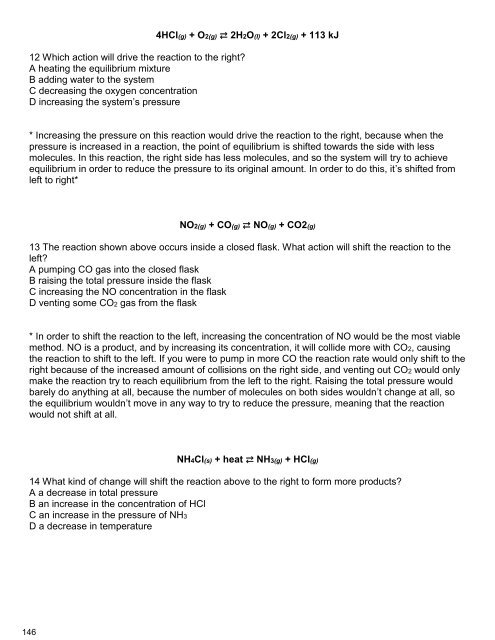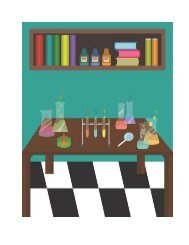(FINAL) Chemistry Notebook 2016-17
- No tags were found...
You also want an ePaper? Increase the reach of your titles
YUMPU automatically turns print PDFs into web optimized ePapers that Google loves.
12 Which action will drive the reaction to the right?<br />
A heating the equilibrium mixture<br />
B adding water to the system<br />
C decreasing the oxygen concentration<br />
D increasing the system’s pressure<br />
4HCl(g) + O2(g) ⇄ 2H2O(l) + 2Cl2(g) + 113 kJ<br />
* Increasing the pressure on this reaction would drive the reaction to the right, because when the<br />
pressure is increased in a reaction, the point of equilibrium is shifted towards the side with less<br />
molecules. In this reaction, the right side has less molecules, and so the system will try to achieve<br />
equilibrium in order to reduce the pressure to its original amount. In order to do this, it’s shifted from<br />
left to right*<br />
NO2(g) + CO(g) ⇄ NO(g) + CO2(g)<br />
13 The reaction shown above occurs inside a closed flask. What action will shift the reaction to the<br />
left?<br />
A pumping CO gas into the closed flask<br />
B raising the total pressure inside the flask<br />
C increasing the NO concentration in the flask<br />
D venting some CO2 gas from the flask<br />
* In order to shift the reaction to the left, increasing the concentration of NO would be the most viable<br />
method. NO is a product, and by increasing its concentration, it will collide more with CO2, causing<br />
the reaction to shift to the left. If you were to pump in more CO the reaction rate would only shift to the<br />
right because of the increased amount of collisions on the right side, and venting out CO2 would only<br />
make the reaction try to reach equilibrium from the left to the right. Raising the total pressure would<br />
barely do anything at all, because the number of molecules on both sides wouldn’t change at all, so<br />
the equilibrium wouldn’t move in any way to try to reduce the pressure, meaning that the reaction<br />
would not shift at all.<br />
NH4Cl(s) + heat ⇄ NH3(g) + HCl(g)<br />
14 What kind of change will shift the reaction above to the right to form more products?<br />
A a decrease in total pressure<br />
B an increase in the concentration of HCl<br />
C an increase in the pressure of NH3<br />
D a decrease in temperature<br />
146





